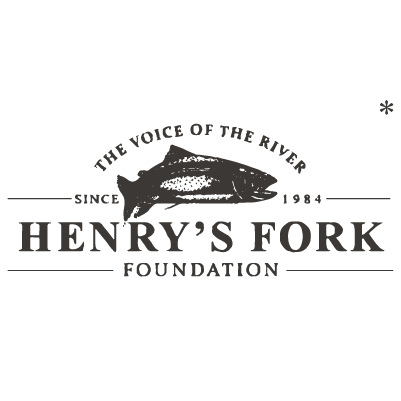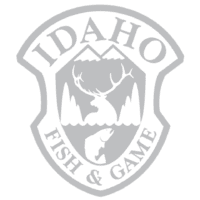The Henry’s Fork Foundation (HFF) is a 501(c)(3) nonprofit organization whose mission, ability to leverage additional funding, expertise, and skills make it uniquely positioned to effectively address the issues at Island Park Reservoir. Our mission is to conserve, restore, and protect the unique fishery, wildlife, and aesthetic qualities of the Henry’s Fork of the Snake River watershed. HFF is supported by donations from its 2,500 members and grants from private foundations and public agencies. Since HFF first hired full-time staff in 1992, science-based collaboration has been the HFF’s primary mode of mission accomplishment. With Fremont-Madison Irrigation District (FMID), HFF co-facilitates the Henry’s Fork Watershed Council, which has become a nationally recognized model of collaborative watershed management and community outreach. The HFF’s science-based work is supported by a science and technology program that includes an in-house water quality/aquatic ecology laboratory and is staffed by five full-time equivalent employees, one graduate students, and as many as six undergraduate interns. The program is directed by Dr. Rob Van Kirk, who has a 25-year record of conducting a wide range of research in the Upper Snake River Watershed to inform conservation and management of fisheries and water resources. Dr. John McLaren is the project manager. He has seven years of experience specifically researching the limnology and ecology of Island Park Reservoir. He is the Aquatic Ecology Program Manager for the Henry’s Fork Foundation; the Aquatic Ecology program uses cutting-edge aquatic ecology concepts to identify permanent infrastructure- and policy-based solutions to anthropogenic pressures on the Henry’s Fork watershed.
Our project goal is to permanently eliminate the drawdown-driven oxythermal habitat squeeze by designing, evaluating, and installing a hypolimnetic oxygenation system. Hypolimnetic oxygenation is a proven technique for improving fish habitat (McQueen & Lean 1986, Horne 2019) and downstream water quality (Horne 2019). In 2021, a hypolimnetic oxygenation system would have increased total habitat for kokanee salmon in Island Park Reservoir from ~1,000 acre feet to ~3,500 acre-feet, an increase of 350%. Absolute habitat savings will be even larger in years where Island Park Reservoir drawdown is lower—preliminary data from Henry’s Fork Foundation monitoring indicates up to 20,000 acre-feet in habitat improvement is possible in years with lower drawdown. Hypolimnetic oxygenation will permanently increase deep, cold-water refugia despite Island Park Reservoir’s shallowness (mean depth = 5 m) and climate-driven uncertainty in water regime. Funds provided by the RFHP will be used to develop a shovel-ready design plan. A shovel-ready plan includes necessary engineering design, stakeholder outreach, plan evaluation, and monitoring. A shovel-ready plan allows us to leverage up to $3 million in USBR WaterSmart grants available through the Infrastructure and Jobs Act and Inflation Reduction Act.
With the help of Reservoir Fish Habitat Partnership (RFHP) funding, HFF will oxygenate Island Park Reservoir’s hypolimnion to restore pelagic migratory salmonid sportfish habitat and improve downstream water quality in the face of habitat loss due to climate change and reservoir draw-down.
- Develop a hypolimnetic oxygenation design plan to oxygenate the Island Park Reservoir hypolimnion to 6 mg/L, including outreach and education to the local community and project stakeholders including Fall River Rural Electric Cooperative through the Henry’s Fork Watershed Council.
- Evaluate plan efficacy through the development of a limnological model for Island Park Reservoir in conjunction with the Idaho Department of Environmental Quality and the Idaho Department of Fish and Game
- Monitor oxythermal habitat and fisheries indicators in Island Park Reservoir through the implementation of continuous temperature and dissolved oxygen monitoring of Island Park Reservoir
- Implement the hypolimnetic oxygenation plan by leveraging funds available from project partners, including U.S. Bureau of Reclamation WaterSmart grants
Completion of these objectives will allow us to continue creating measurable improvements in water quality and fish habitat in a valuable fishery resource, reduce management uncertainty, and potentially restore Island Park Reservoir’s fishery to a quality not seen since the 1980s.
Methods
Objective 1 conducts the critical preliminary scoping, design, and siting work to create a shovel-ready plan for a hypolimnetic oxygenation facility. Multiple potential hypolimnetic oxygenation designs have individual benefits and drawbacks in effectiveness, space and siting requirements, initial cost, and ongoing operating and maintenance costs (Miranda 2017). Project scoping is initially determined by the amount of oxygen required for the project, which is controlled by oxygenation goals, the volume of water to be oxygenated, and the induced oxygen demand resulting from oxygenation. Induced demand can affect project scope by affecting both infrastructure design as well as the amount of oxygen required to reach project goals (Beutel 2003, Miranda 2017). RFHP funding will identify Island Park Reservoir’s stable and induced oxygen demand to accurately identify project scope. Next, RFHP funding will be used to contract an engineering firm with expertise in hypolimnetic oxygenation to design and site a hypolimnetic oxygenation system that will be capable of oxygenating Island Park Reservoir’s hypolimnion to 6 mg/L of dissolved oxygen. We chose this standard because it exceeds minimum survival requirements for salmonid sportfish (Davis 1975, Berge 2009), and because it would allow FRREC to operate their hydroelectric facility without pause. This would maximize in-reservoir fish habitat, upstream salmonid runs, and downstream water quality. A shovel-ready design plan will next be evaluated with objectives 2 and 3, which will be aimed at building outreach and support for the project with stakeholders and the local community. Finally, a shovel-ready design plan can be used to accomplish objective 4: implementation.
Objective 2 aims to develop mechanistic and predictive models of water quality and fish habitat, thereby assisting in improving precision management and water conservation. Tools like Delft3D and CE-QUAL W2 by the US Geological Survey can produce 3D models of water temperature and dissolved oxygen in reservoir systems given known inputs like depth, local weather, and the quantity and quality of inflows and outflows. Once calibrated, these models can predict future water quality conditions in Island Park Reservoir given a wide range of scenarios, such as with a hypolimnetic oxygenation plan. This transition from reactive monitoring to proactive prediction represents a major step forward for smart management of Island Park Reservoir and its fisheries resources. It also represents a major step forward in outreach and stakeholder engagement. Showing the efficacy of hypolimnetic oxygenation will lead to additional non-federal match as more stakeholders—in particular IDFG, FRREC, and other partners through the HFF’s proven collaborative management, outreach, and education.
Objective 3 continues the HFF’s comprehensive monitoring of water quality in Island Park Reservoir to assess the efficacy of management actions on Island Park Reservoir. Findings from 2021 revealed significant spatial variability in water quality in Island Park Reservoir. An undergraduate intern presented the findings of our 2021 RFHP-funded work to the public through the HFF’s popular “Summer Seminar Series”, and we intend to continue to engage with community members in reporting our scientific findings (https://www.henrysfork.org/post/4th-annual-hff-summer-seminar-series). Monitoring will assist in pre-project monitoring of a hypolimnetic oxygenation project.
Objective 4 is the implementation of the plan developed through objective 1. USBR WaterSmart infrastructure grants such as the Environmental Water Resources Program require projects with clear, quantifiable benefits to aquatic habitats and water quality, a clear strategy or plan with significant stakeholder support, a shovel-ready design plan, and a pre- and post-project monitoring plan. Objective 1 produces a shovel-ready design plan, and objectives 2 and 3 will allow for further quantification of specific benefits, a path for developing a clear plan with significant stakeholder support through the Henry’s Fork Foundation’s science-based collaboration model, and infrastructure for pre- project monitoring. Objectives 1-3 will produce a very strong proposal to develop a permanent infrastructure solution to Island Park Reservoir’s declining water quality, thereby increasing fish habitat quantity by an order of magnitude, improving downstream water quality, and benefitting a $30 million angling-based economy.
Monitoring Plan
We will collect vertical profiles of water temperature, turbidity, dissolved oxygen, chlorophyll-a, and phycocyanin concentrations at five different locations in Island Park Reservoir selected to represent five distinct habitat units in Island Park Reservoir. This information was critical to the publication of McLaren et al. 2023, and has provided indispensable information critical to the management of Island Park Reservoir. In fact, it is because of this continued monitoring that a hypolimnetic oxygenation project–and its many benefits–became a possibility both for the Henry’s Fork Foundation and for our managing partners.
Objective 3 continues the HFF’s comprehensive monitoring of water quality in Island Park Reservoir to assess the efficacy of management actions on Island Park Reservoir. Findings from 2021 revealed significant spatial variability in water quality in Island Park Reservoir. An undergraduate intern presented the findings of our 2021 RFHP-funded work to the public through the HFF’s popular “Summer Seminar Series”, and we intend to continue to engage with community members in reporting our scientific findings (https://www.henrysfork.org/post/4th-annual-hff-summer-seminar-series). Monitoring will assist in pre-project monitoring of a hypolimnetic oxygenation project.
Outreach Plan
Objective 2 aims to develop mechanistic and predictive models of water quality and fish habitat, thereby assisting in improving precision management and water conservation. Tools like Delft3D and CE-QUAL W2 by the US Geological Survey can produce 3D models of water temperature and dissolved oxygen in reservoir systems given known inputs like depth, local weather, and the quantity and quality of inflows and outflows. Once calibrated, these models can predict future water quality conditions in Island Park Reservoir given a wide range of scenarios, such as with a hypolimnetic oxygenation plan. This transition from reactive monitoring to proactive prediction represents a major step forward for smart management of Island Park Reservoir and its fisheries resources. It also represents a major step forward in outreach and stakeholder engagement. Showing the efficacy of hypolimnetic oxygenation will lead to additional non-federal match as more stakeholders—in particular IDFG, FRREC, and other partners through the HFF’s proven collaborative management, outreach, and education. In particular, results will be presented at the Henry’s Fork watershed council, which conducts an annual conference to discuss major future projects in the Henry’s Fork watershed.


